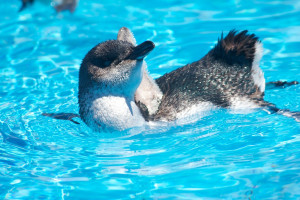Surprising discovery: parrots, pigeons and penguins share Chlamydia strain connections across Australia and Aotearoa New Zealand
In an innovative collaboration, a team of scientists from a range of institutions – including the Institute of Environmental Science and Research (ESR), Massey University, Ministry for Primary Industries, NSW Department of Primary Industries, University of Amsterdam, and the University of the Sunshine Coast (lead) – have unveiled unexpected findings in the epidemiology of chlamydial infections.
Their research, published with open access in the journal Microbial Genomics, showcases the use of whole-genome sequencing to unravel the DNA sequence of Chlamydia psittaci, a pathogen commonly found in parrots and pigeons, from various bird species in Australia and Aotearoa New Zealand (1).
Chlamydia trachomatis, a type of bacteria, is commonly recognised as a sexually transmitted infection in humans. However, there is another species known as Chlamydia psittaci, which is responsible for causing psittacosis (also known as parrot fever and ornithosis), a disease affecting birds. In humans, psittacosis can manifest in different ways, ranging from asymptomatic infection or a mild flu-like illness to a more severe systemic condition, which may include atypical pneumonia.
Chlamydia psittaci was first identified in New Zealand in 1953 in recently imported Australian parrots and the keepers who cared for them (2). In a series of sporadic reports following the initial identification in 1953, Chlamydia psittaci has been detected in various exotic species of parrots (3,4) and feral pigeons (5).
Alarmingly, it has been linked to a mortality cluster among wild Malay doves in Auckland/Tāmaki Makaurau (6). Notably, asymptomatic infections have been reported in native New Zealand birds like the Hihi (4) and Kea (7), even after their export to an overseas zoo. However, there are only a few studies in New Zealand that investigate Chlamydia psittaci in native and introduced birds. This is mainly because Chlamydia psittaci resides inside cells, making it challenging to study. The process of culturing and isolating Chlamydia psittaci is difficult and time-consuming, leading to limited amounts of chlamydial genetic material, which is often mixed with host DNA and contaminated.
The open access research paper Whole-genome sequencing of Chlamydia psittaci from Australasian avian hosts: A genomics approach to a pathogen that still ruffles feathers(external link) sheds light on the presence of a specific Chlamydia psittaci type, known as sequence type (ST)24, in New Zealand parrots. Meanwhile, New Zealand pigeons exhibited a more diverse range of strains, aptly called the “pigeon clade” or “pigeon-type” strains. Molecular epidemiology reveals that these “pigeon-type” strains exist in various hosts across New Zealand. Surprisingly, these strains have been identified not only in pigeons themselves but also in other avian species, including a captive Zebra Finch, Diamond Dove, Superb Parrot, and our beloved Little Blue Penguin/Kororā.
To advance our understanding of the distribution of this pathogen amidst vulnerable populations in an ever-changing world, the researchers aim to study various avian environments throughout New Zealand, ranging from the open ocean to urban areas. Such research holds the potential to bolster our preparedness against infectious diseases in the country. However, this endeavour requires funding to investigate the prevalence and burden of Chlamydia psittaci in New Zealand.
With financial support, the researchers can embark on an ambitious journey to gather crucial information that will have substantial implications for public health, disease management, and avian conservation efforts - enabling us to develop effective strategies to protect the health of Aotearoa’s beloved birds.
This study was funded by Australian Research Council Discovery Early Career Research Award (DECRA) awarded to Dr Martina Jelocnik from the University of the Sunshine Coast.
References
- Kasimov V, White RT, Foxwell J, Jenkins C, Gedye K, Pannekoek Y, Jelocnik M. Whole-genome sequencing of Chlamydia psittaci from Australasian avian hosts: A genomics approach to a pathogen that still ruffles feathers. Microbial Genomics 2023;9:001072.
- Fastier LB, Austin FJ. Psittacosis among Australian parrots imported into New Zealand. The New Zealand Medical Journal 1954;53:373-379.
- McCausland IP, Carter ME, O'Hara PJ. Clinical ornithosis in a New Zealand aviary. New Zealand Veterinary Journal 1972;20:53-54.
- Gartrell BD, French NP, Howe L, Nelson NJ, Houston M, Burrows EA, Russell JC, Anderson SH. First detection of Chlamydia psittaci from a wild native passerine bird in New Zealand. New Zealand Veterinary Journal 2013;61:174-176.
- Motha J, Reed C, Gibbons A. The prevalence of Chlamydia psittaci in feral pigeons and native psittacines. Surveillance 1995;22:20-22.
- Rawdon TG, Potter JS, Harvey CJ, Westera BF. Chlamydiosis (psittacosis) in Malay spotted doves Streptopelia chinesis. Kokako 2009;16:54–56.
- Johnson FW, Lyon DG, Wilkinson R, Bloomfield P, Philips HL. Isolation of Chlamydia psittaci from newly imported Keas (Nestor notabilis). The Veterinary Record 1984;114:298-299.

